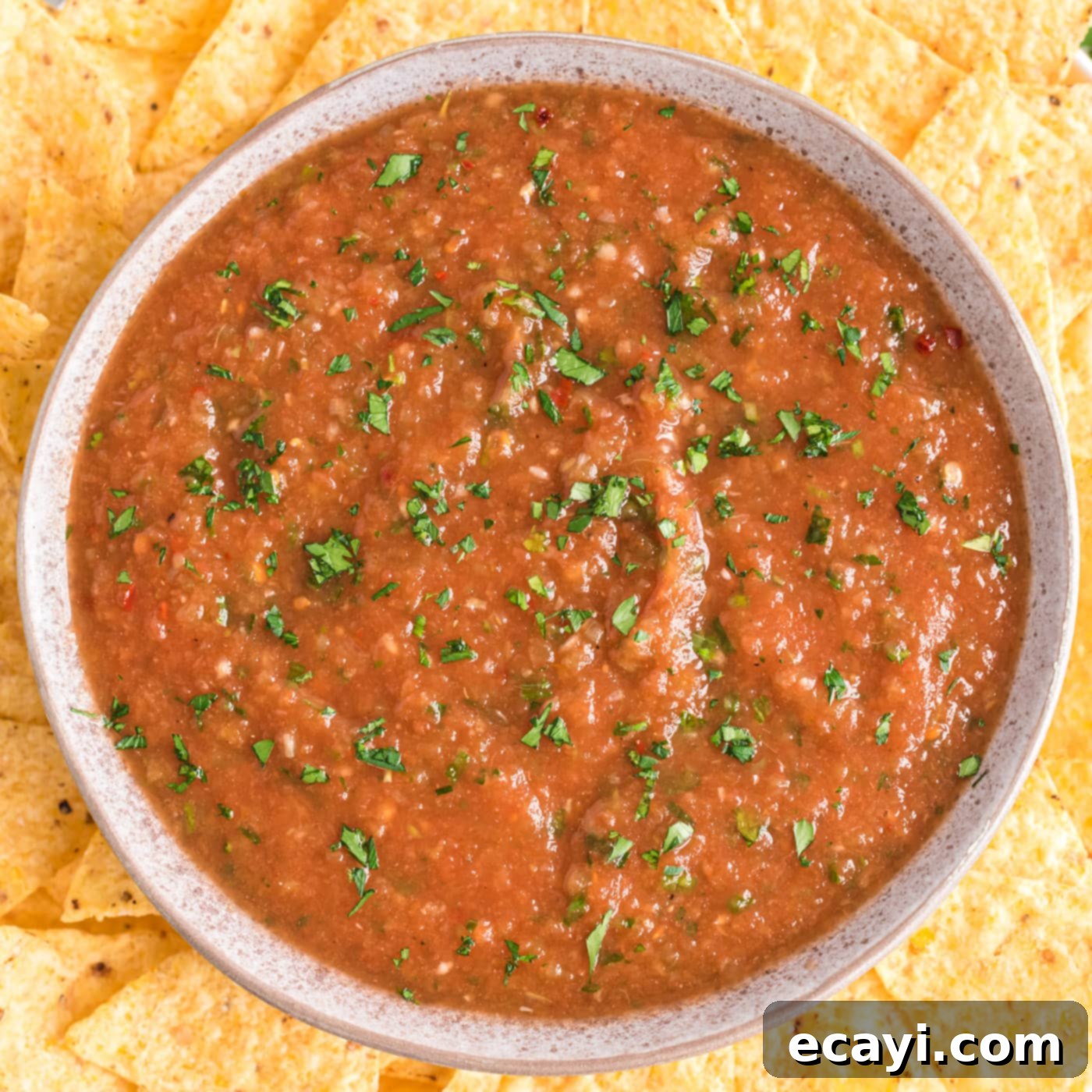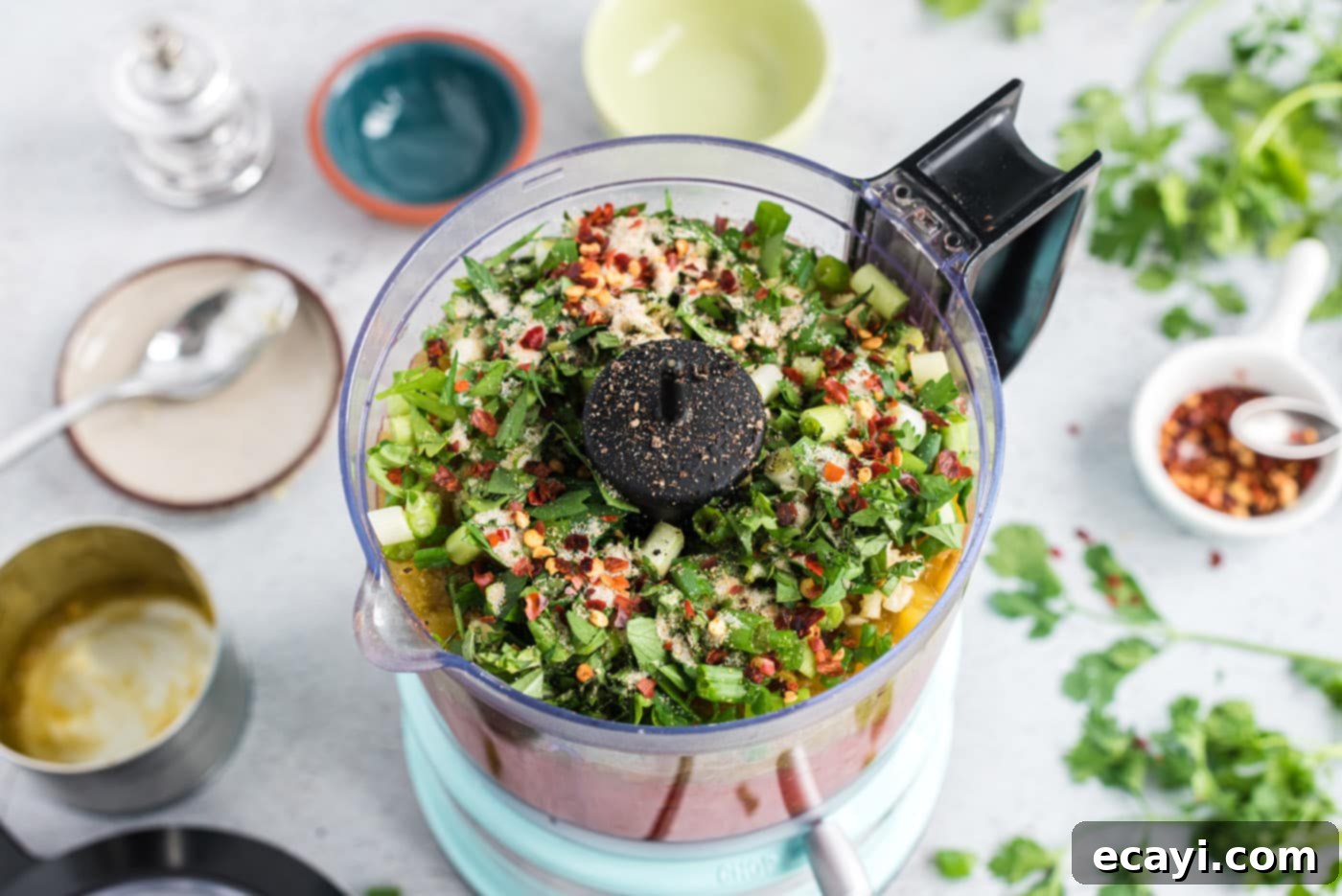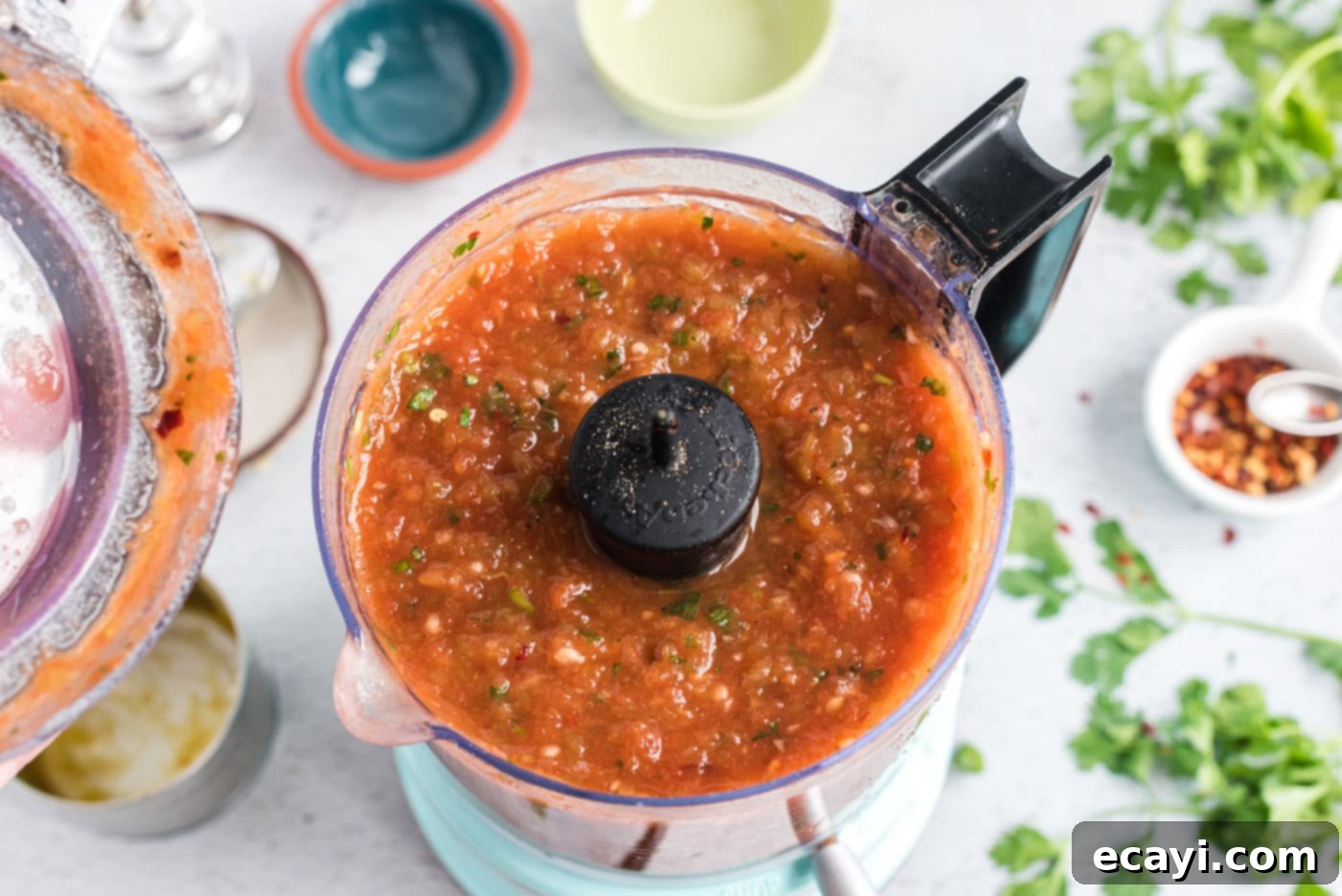The Best 10-Minute Restaurant Style Salsa: Easy Homemade Dip from Canned Tomatoes
Imagine diving into a bowl of vibrant, zesty restaurant-style salsa, perfectly balanced with a kick of spice, all made effortlessly in your own kitchen. This incredible recipe transforms simple canned ingredients into a sensational dip in less than 10 minutes. Forget bland store-bought versions; this homemade salsa offers that authentic, fresh flavor you crave, ideal for any occasion. Whether you’re hosting a party or simply enjoying a quiet night in, this quick and easy salsa is guaranteed to be a crowd-pleaser, delivering deliciousness with minimal effort.
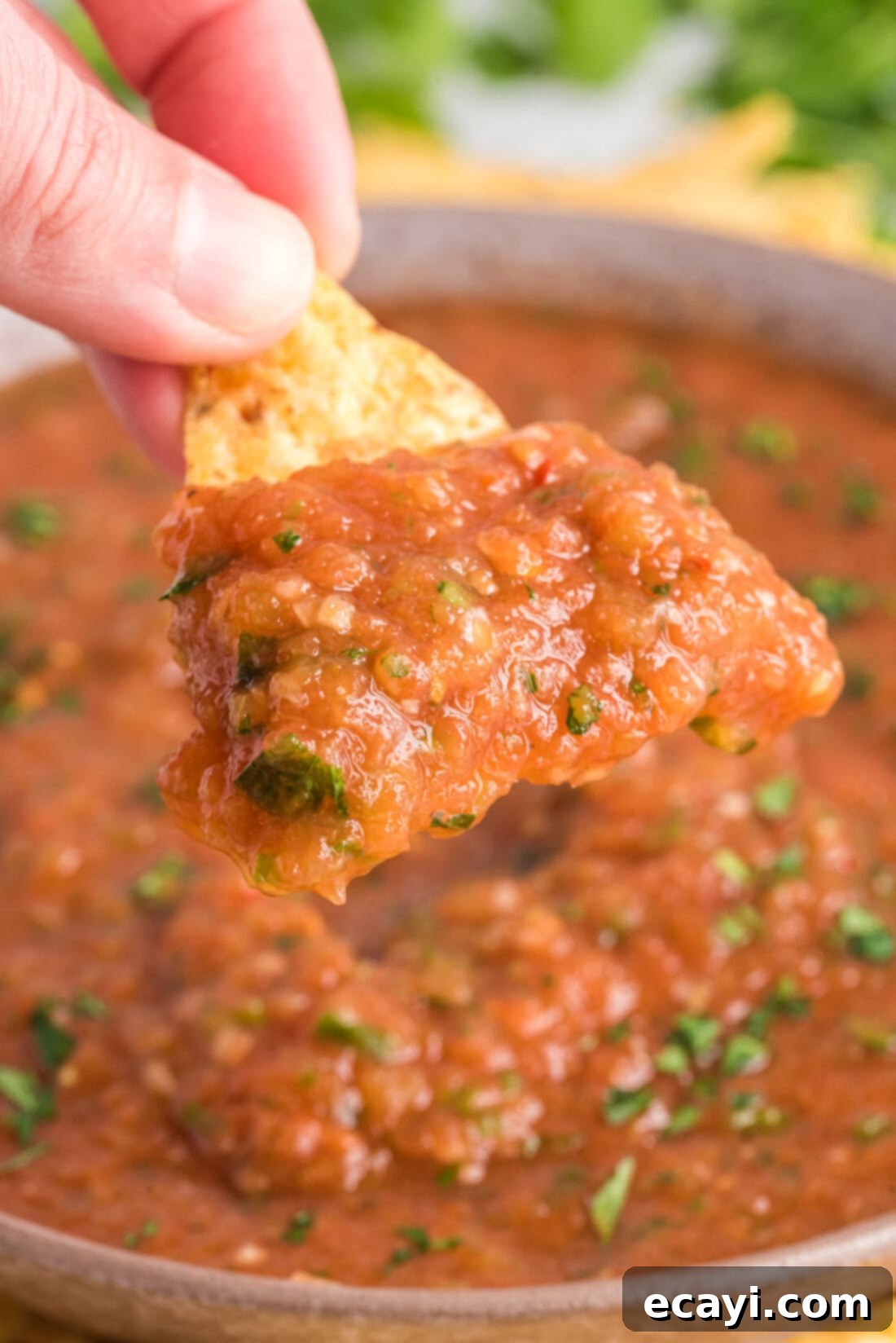
Why This Restaurant-Style Salsa Recipe is a Game Changer
There’s nothing quite like the taste of fresh, homemade salsa, especially when tomatoes are bursting with flavor straight from the garden. However, when the chill of winter sets in, fresh garden tomatoes become a distant memory, and grocery store varieties often lack the vibrant taste and firm texture needed for an exceptional salsa. This is precisely where this recipe shines, offering a brilliant solution: canned tomatoes.
By harnessing the consistent quality and rich flavor of fire-roasted canned tomatoes, we can achieve an outstanding restaurant-style salsa regardless of the season. My usual salsa fresca relies on peak-season produce, but this version proves that convenience doesn’t mean compromising on taste. Paired with a handful of other simple ingredients and the speed of a food processor or blender, this recipe delivers a smooth yet slightly chunky salsa that tastes like it came straight from your favorite Mexican eatery. It’s incredibly simple to prepare, making it a go-to for busy weeknights, impromptu gatherings, or whenever a salsa craving strikes. Just combine your ingredients, pulse, and in mere moments, you’ll have a delightful dip ready to enjoy. This truly is one of the easiest and most rewarding food processor recipes you’ll ever master.
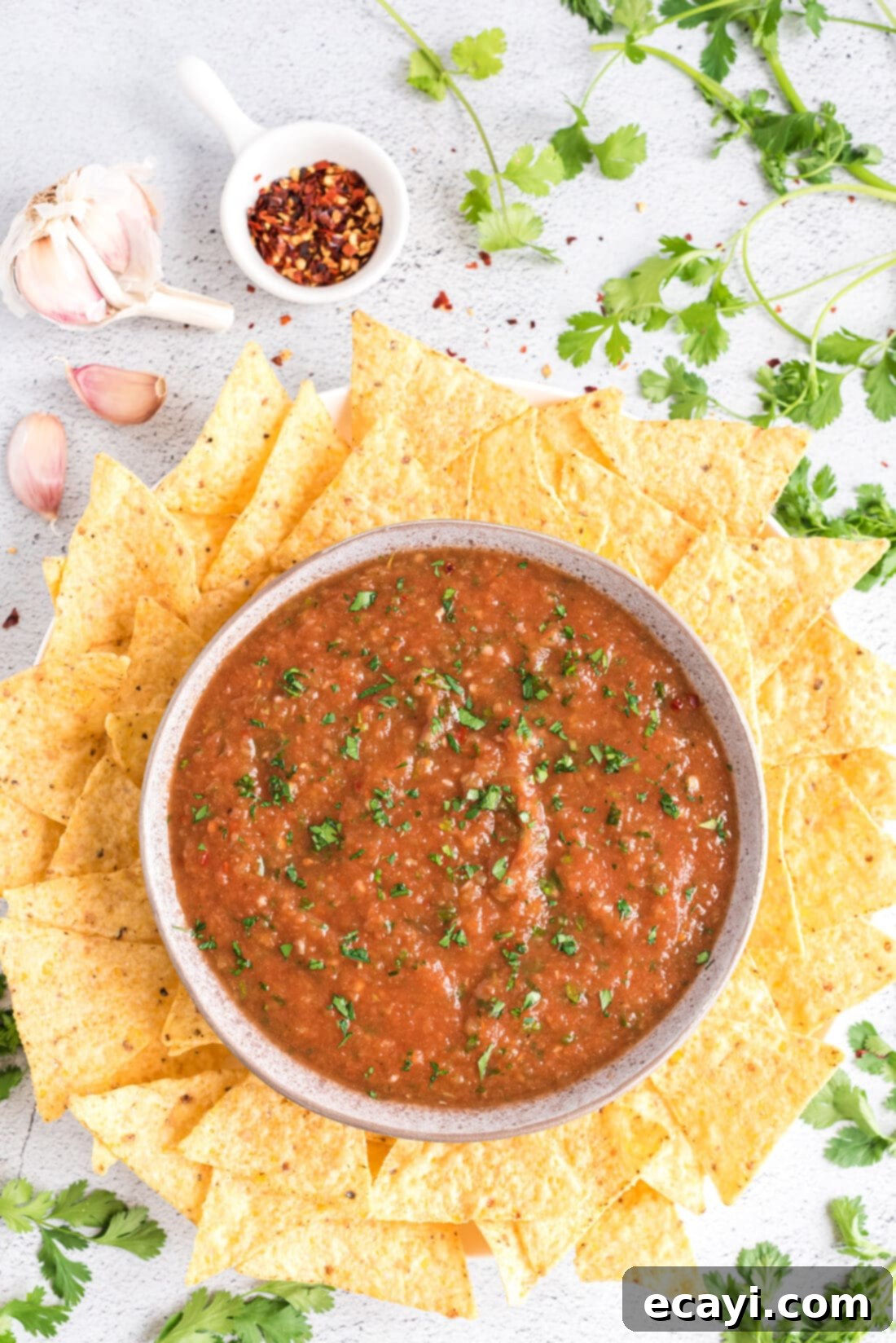
Essential Ingredients for Your Homemade Salsa
Crafting the perfect restaurant-style salsa begins with a carefully selected array of fresh and pantry staples that work in harmony to build complex flavors. While you’ll find all precise measurements and detailed instructions in the printable recipe card at the conclusion of this post, here’s an overview of the key components that bring this salsa to life:
- **Canned Tomatoes:** The foundation of our salsa, providing rich tomato flavor year-round.
- **Canned Green Chiles:** These add a mild, earthy heat and a distinctive Tex-Mex character without overwhelming the palate.
- **Fresh Garlic:** Essential for its pungent, aromatic depth, elevating the overall taste profile.
- **Green Onions:** Offering a milder, fresher onion flavor compared to traditional onions, they contribute a subtle sharpness.
- **Fresh Cilantro:** A hallmark of Mexican cuisine, cilantro provides a bright, herbaceous note that is simply irreplaceable for that authentic taste.
- **Garlic Salt:** Enhances both the garlic and savory elements of the salsa.
- **Freshly Ground Black Pepper:** A pantry staple that adds a foundational layer of flavor.
- **Red Pepper Flakes:** For a touch of heat that can be easily adjusted to your preference.
Each ingredient plays a crucial role in creating a salsa that is both vibrant and deeply flavorful, perfectly mimicking the restaurant experience.
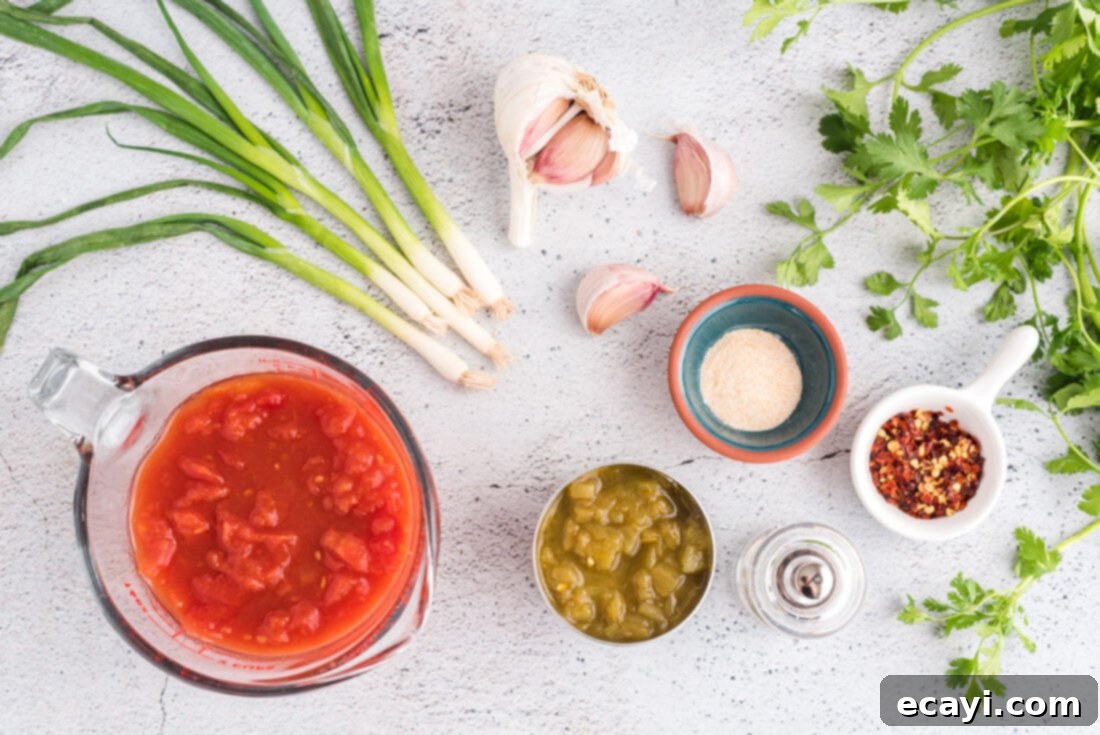
Ingredient Spotlight & Smart Substitutions
Understanding each ingredient’s role and knowing how to make smart substitutions can greatly enhance your salsa-making experience and adapt the recipe to your preferences or what you have on hand.
- TOMATOES: For canned tomatoes, I consistently reach for Hunts Fire Roasted. The fire-roasting process infuses the tomatoes with a subtle smoky depth that truly elevates the salsa’s flavor, giving it a complexity that rivals fresh, grilled tomatoes. However, feel free to use your preferred brand of whole or chopped canned tomatoes. If you happen to have homemade canned tomatoes, they would be an excellent choice. A fantastic substitution for an added layer of flavor and mild heat is Rotel tomatoes with green chiles. If you opt for Rotel, remember to omit the additional canned green chiles called for in the recipe card to avoid excessive heat or flavor. Diced or crushed tomatoes can also work, though they might result in a slightly different texture than whole tomatoes.
- GREEN CHILES: The canned green chiles provide a mild, slightly tangy heat and an earthy undertone that is characteristic of many restaurant salsas. They are crucial for that authentic flavor. If you want to boost the heat, consider adding a fresh jalapeño or serrano pepper, as detailed in our FAQs.
- GARLIC: Freshly minced garlic is always recommended for the most potent and vibrant flavor. The difference between fresh and powdered garlic is significant in a recipe where fresh ingredients are blended. However, if fresh garlic isn’t available, you can substitute with garlic powder, using about 1 teaspoon of powder for every 3 cloves of fresh garlic. Adjust to your taste, as powdered garlic tends to be more concentrated.
- GREEN ONIONS: These provide a milder, sweeter onion flavor than red or white onions, and their fresh, slightly grassy notes complement the other ingredients beautifully. If you don’t have green onions, a small amount of finely diced white or red onion can be used, but you might want to soak them in ice water for 10-15 minutes to mellow their strong flavor before adding them to the blender.
- CILANTRO: Fresh cilantro is absolutely vital for that classic, bright, and herbaceous Mexican flavor profile. It truly makes the salsa sing. If you are one of those individuals who find cilantro tastes soapy (due to a genetic predisposition), you can substitute with fresh parsley, or a combination of parsley and a very small amount of oregano, though the flavor profile will be noticeably different.
- SEASONINGS (Garlic Salt, Black Pepper, Red Pepper Flakes): These seasonings allow you to fine-tune the flavor. Garlic salt provides a convenient blend of salt and garlic. If using regular salt and garlic powder, adjust quantities to achieve the desired balance. Red pepper flakes add a subtle, building heat. For a spicier salsa, don’t hesitate to increase the amount or introduce fresh chilies. Always taste and adjust seasonings to your personal preference before serving.
Crafting Your Perfect Restaurant Style Salsa
These step-by-step photos and instructions are here to help you visualize how to make this recipe. For the complete, printable version of this recipe, including all measurements and detailed instructions, simply Jump to Recipe at the bottom of this post.
-
Layer Your Ingredients: Begin by adding all of your meticulously prepared ingredients into your food processor or blender. It’s often beneficial to layer them in the order listed, starting with liquids and softer ingredients, to ensure even blending and prevent larger chunks from getting stuck. This helps the blades catch everything effectively from the start.

-
Process to Perfection: Once all ingredients are in, secure the lid and pulse a few times to initially break down and combine the ingredients. If you prefer a chunkier salsa with more texture, continue using the pulse feature, stopping periodically to check the consistency. For a smoother, more restaurant-like consistency with small, uniform pieces, I typically process mine for about 30-45 seconds. The key is to blend until it reaches your desired texture—fairly smooth with discernible small chunks of flavor. Don’t over-process, as this can make the salsa watery and compromise its vibrant color.

Frequently Asked Questions & Expert Tips
Yes, absolutely! A blender will work perfectly fine for this salsa. The main difference you might notice is that a blender can create an even smoother consistency, while a food processor tends to leave slightly more texture. If you prefer a chunkier salsa with a blender, use the pulse function in short bursts and avoid over-blending.
This homemade salsa maintains its fresh flavor and quality when stored properly. Be sure to transfer it to an airtight container and keep it refrigerated. It will stay delicious for up to 4 days. For optimal freshness, a glass mason jar is an excellent choice for storage.
When it comes to canning, a crucial food safety rule of thumb is to avoid re-canning ingredients that have already been commercially canned. Since this recipe utilizes canned tomatoes and green chiles, it is not suitable for home canning due to potential pH imbalances and safety concerns. If you are eager to preserve your homemade salsa through canning, your best approach is to follow a traditional canning-safe recipe that uses entirely fresh ingredients. My salsa fresca recipe, which features fresh tomatoes and very similar ingredients, can be adapted for canning by blending and processing according to tested canning guidelines.
This recipe, as written, creates a salsa that is on the milder side, making it appealing to a wide range of palates. If you’re looking to turn up the heat, there are several easy ways to customize the spice level:
- Fresh Jalapeño: For a significant kick, add a freshly chopped jalapeño pepper. To increase the heat further, leave some of the rib and seeds intact, as this is where much of the capsaicin (the compound responsible for spice) is concentrated.
- Serrano Peppers: For an even hotter salsa, substitute a jalapeño with a serrano pepper. Serranos are typically much spicier than jalapeños.
- Extra Red Pepper Flakes: Simply increase the amount of red pepper flakes beyond what the recipe suggests.
- Hot Sauce: A few dashes of your favorite hot sauce can be blended in at the end to achieve your desired level of heat.
Always taste as you go when adjusting spice, especially with fresh chilies, as their heat can vary.
Like many dishes, especially those with fresh herbs and aromatics, this salsa benefits from a short chilling period. Resting in the refrigerator for at least 30 minutes, or even better, overnight, allows the flavors to meld and deepen. The garlic, cilantro, and spices infuse more thoroughly with the tomatoes, resulting in a more harmonious and robust taste profile. For the best flavor, always make it a little ahead of time if possible!
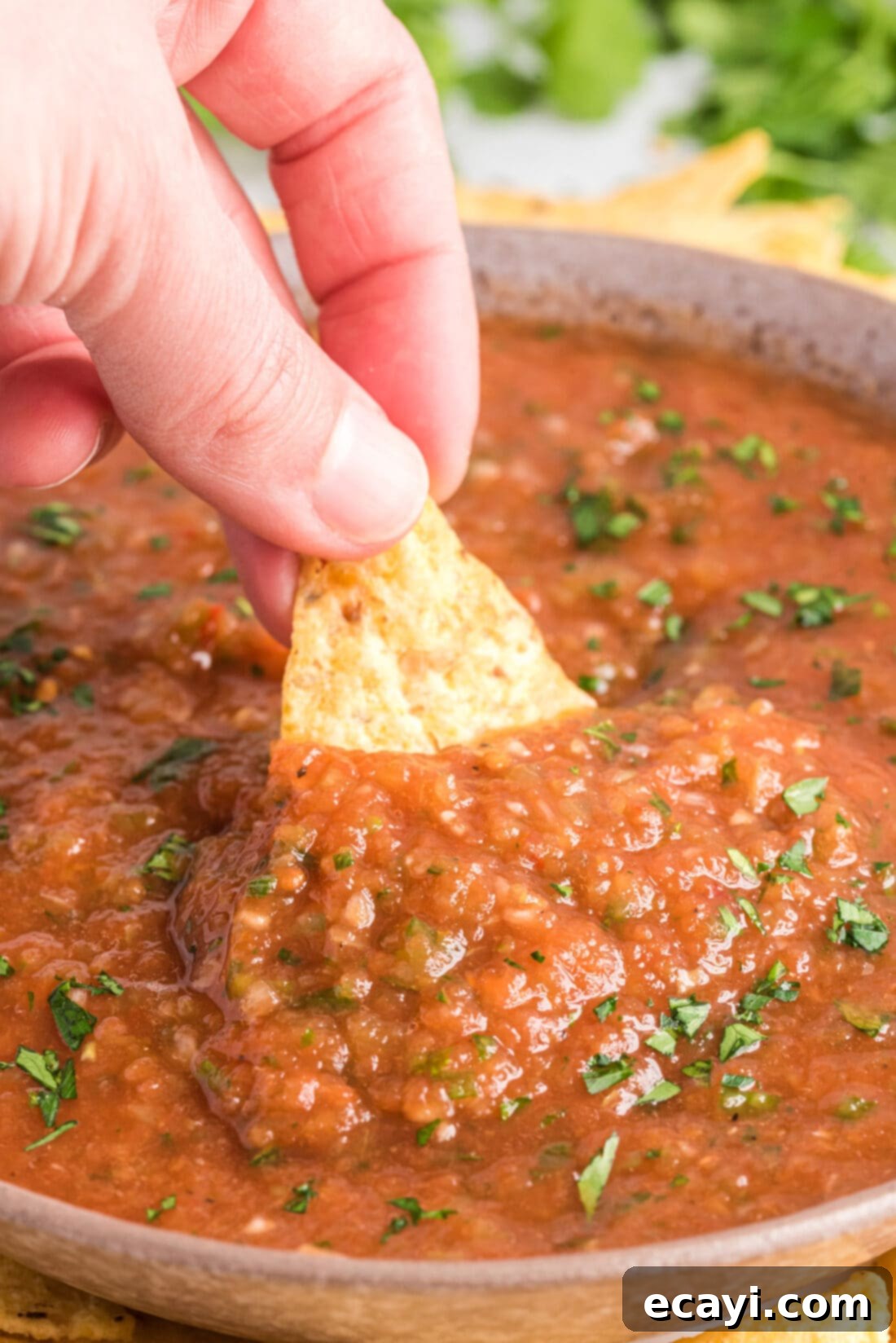
Delightful Serving Suggestions for Your Salsa
There’s rarely a wrong time to enjoy this delectable restaurant-style salsa! Its versatility makes it perfect for almost any occasion. Serve it as an irresistible appetizer at potlucks, football parties, summer cookouts, or game nights. Of course, it’s a quintessential pairing with classic tortilla chips, but don’t limit yourself! This salsa also shines when layered into hearty burritos, generously drizzled over savory tacos, enchiladas, or even creative dishes like walking tacos. It makes an excellent topping for loaded nachos, a zesty accompaniment to grilled chicken or fish, a flavorful addition to scrambled eggs, or even a vibrant sauce for a burrito bowl. Get creative and enjoy the fresh, bold flavors!
Explore More Vibrant Salsa Recipes
If you loved this easy restaurant-style salsa, you’re in for a treat! Our collection features a variety of other exciting salsa recipes, each offering a unique flavor profile to complement different meals and moods. Expand your culinary repertoire with these fantastic options:
- Salsa Verde: A tangy, bright green salsa made with tomatillos.
- Corn Salsa: Sweet corn meets zesty ingredients for a delightful texture.
- Mango Salsa: A sweet and savory tropical blend, perfect with seafood.
- Cowboy Caviar: A hearty, colorful bean and corn salad that doubles as a dip.
- Strawberry Salsa: Unexpectedly delicious, offering a fresh, fruity twist.
- Easy Pineapple Salsa: Another tropical favorite, balancing sweetness with a gentle tang.
I love to bake and cook and share my kitchen experience with all of you! Remembering to come back each day can be tough, that’s why I offer a convenient newsletter every time a new recipe posts. Simply subscribe and start receiving your free daily recipes!

Restaurant Style Salsa
IMPORTANT – There are often Frequently Asked Questions within the blog post that you may find helpful. Simply scroll back up to read them!
Print It
Pin It
Rate It
Save ItSaved!
Ingredients
- 14 ounce canned tomatoes 1 can whole or chopped
- 4 ounce green chiles 1 can
- 3 teaspoons garlic minced
- 5 green onions coarsely chopped
- 1 handful fresh cilantro coarsely chopped, about 1/2 cup or to taste
- garlic salt to taste
- freshly ground black pepper 4 or 5 turns or to taste
- ¼ teaspoon red pepper flakes
Things You’ll Need
-
Food processor or blender
-
Chef’s knife
-
Cutting board
Before You Begin
- This recipe will make roughly 2 cups of vibrant salsa. If you’re expecting a larger gathering or simply want more to enjoy, feel free to easily double the recipe.
- For optimal freshness and flavor, store your homemade salsa in an airtight container, such as a glass mason jar, and keep it refrigerated. It will stay delicious for up to 4 days.
- The salsa, as described, offers a mild flavor profile. To add more heat, incorporate a freshly chopped jalapeño (including some ribs and seeds for extra spice) or simply increase the quantity of red pepper flakes to your liking.
Instructions
-
Carefully layer all the ingredients into the bowl of your food processor or blender, following the order in which they are listed to ensure even processing.
-
Pulse the ingredients a few times to get them mixed and coarsely chopped. Continue using the pulse feature until your salsa reaches your preferred consistency – from slightly chunky to a smoother, restaurant-style blend. I usually process mine for about 30-45 seconds, stopping when it looks just right.
Nutrition
The recipes on this blog are tested with a conventional gas oven and gas stovetop. It’s important to note that some ovens, especially as they age, can cook and bake inconsistently. Using an inexpensive oven thermometer can assure you that your oven is truly heating to the proper temperature. If you use a toaster oven or countertop oven, please keep in mind that they may not distribute heat the same as a conventional full sized oven and you may need to adjust your cooking/baking times. In the case of recipes made with a pressure cooker, air fryer, slow cooker, or other appliance, a link to the appliances we use is listed within each respective recipe. For baking recipes where measurements are given by weight, please note that results may not be the same if cups are used instead, and we can’t guarantee success with that method.
This post originally appeared here on Jan 13, 2011, and has since been extensively updated with new photos, expanded content, and expert tips to enhance your cooking experience.
